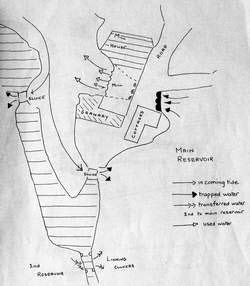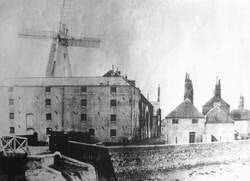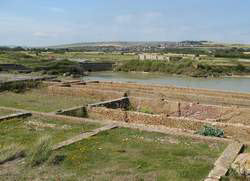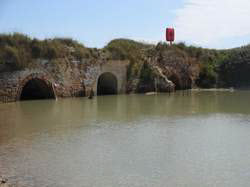Abandoned Communities ..... Tide Mills
Around 1770 a flour mill, driven by tidal power, opened very near the coast of Sussex. A small village grew up around the mill. The mill itself closed in 1883, but the village, still known as Tide Mills, continued to be occupied. Eventually in 1937 some of the village residents had to leave because their dwellings were declared unfit for human habitation. The remaining residents moved away in 1940 as the area was needed for defensive purposes in case of invasion.
The possibility of using tidal energy arose from the geography of the coastline between Newhaven and Seaford. In the early eighteenth century the river Ouse flowed south towards the sea but took a sharp turn to the east as it approached the shingle bank that formed the seashore. The river ran along behind the shingle for a mile and a half before discharging into the sea at Seaford. Then in the early 1730s a cut was made through the shingle spit that allowed the Ouse to flow straight into the sea at Newhaven. Incoming tides entered the mouth of the Ouse and as well as running up the river would flow into the old channel to the east.
Three corn merchants, John Challen, William Woods, and John Woods, saw the opportunity to make use of the tide running into the old channel. In addition it was possible for ships of up to 140 tons to sail along the channel around high tide to deliver coal, grain and other supplies and to carry away flour. The demand for flour in London and elsewhere was increasing, and it was cheaper to transport it by sea than by land. In 1761 Challen, Woods, and Woods took a 500 year lease from the owner of the land, the Duke of Newcastle, and obtained a private Act of Parliament that allowed them to build a dam for the mill across the channel and to construct a wharf close to the mill.
Quotations from the Act of Parliament and much information about the history of Tide Mills can be found in David Lyndhurst's book Bishopstone and the Lost Village of Tide Mills, SB Publications. If you order the book from Amazon make sure you get a copy of the 2008 edition. I am very grateful to David Lyndhurst for the support he has given in the preparation of this section. Other sources of information are Peter Longstaff-Tyrrell, Lost Villages of East Sussex, GoteHouse Publishing, 2008, and the Tidemills at Bishopstone website.
The mill operated by taking water from a very large mill pond east of the mill. Each incoming tide would bring water up the channel on the west side of the mill, and the water would pass through an automatic sluice gate into the pond. When the tide turned water would flow from the mill pond and drive three undershot water wheels housed in arches in the dam. The system is illustrated by the diagram on the left. At first there were five pairs of mill stones capable of producing 1200 sacks of flour a week.
Tide Mills was involved in a major incident in 1795. Britain had entered the war with France in 1793, and to guard against possible invasion militia groups were stationed along the south coast of England. Sections of the militia at Blatchington, aggrieved at their inadequate food supply, mutinied in April 1795. Having seized food from shopkeepers in Seaford they moved to Tide Mills. Two men were charged with stealing 1000 bushels of flour from the sloop Lucy, moored at the Tide Mills wharf, and another was charged with stealing three quarts of rum and a quantity of flour from the mill. Eventually the mutiny was suppressed by troops from Brighton. Five ringleaders were executed, and other participants were transported.
The possibility of using tidal energy arose from the geography of the coastline between Newhaven and Seaford. In the early eighteenth century the river Ouse flowed south towards the sea but took a sharp turn to the east as it approached the shingle bank that formed the seashore. The river ran along behind the shingle for a mile and a half before discharging into the sea at Seaford. Then in the early 1730s a cut was made through the shingle spit that allowed the Ouse to flow straight into the sea at Newhaven. Incoming tides entered the mouth of the Ouse and as well as running up the river would flow into the old channel to the east.
Three corn merchants, John Challen, William Woods, and John Woods, saw the opportunity to make use of the tide running into the old channel. In addition it was possible for ships of up to 140 tons to sail along the channel around high tide to deliver coal, grain and other supplies and to carry away flour. The demand for flour in London and elsewhere was increasing, and it was cheaper to transport it by sea than by land. In 1761 Challen, Woods, and Woods took a 500 year lease from the owner of the land, the Duke of Newcastle, and obtained a private Act of Parliament that allowed them to build a dam for the mill across the channel and to construct a wharf close to the mill.
Quotations from the Act of Parliament and much information about the history of Tide Mills can be found in David Lyndhurst's book Bishopstone and the Lost Village of Tide Mills, SB Publications. If you order the book from Amazon make sure you get a copy of the 2008 edition. I am very grateful to David Lyndhurst for the support he has given in the preparation of this section. Other sources of information are Peter Longstaff-
The mill operated by taking water from a very large mill pond east of the mill. Each incoming tide would bring water up the channel on the west side of the mill, and the water would pass through an automatic sluice gate into the pond. When the tide turned water would flow from the mill pond and drive three undershot water wheels housed in arches in the dam. The system is illustrated by the diagram on the left. At first there were five pairs of mill stones capable of producing 1200 sacks of flour a week.
Tide Mills was involved in a major incident in 1795. Britain had entered the war with France in 1793, and to guard against possible invasion militia groups were stationed along the south coast of England. Sections of the militia at Blatchington, aggrieved at their inadequate food supply, mutinied in April 1795. Having seized food from shopkeepers in Seaford they moved to Tide Mills. Two men were charged with stealing 1000 bushels of flour from the sloop Lucy, moored at the Tide Mills wharf, and another was charged with stealing three quarts of rum and a quantity of flour from the mill. Eventually the mutiny was suppressed by troops from Brighton. Five ringleaders were executed, and other participants were transported.
One
The flow of water at Tide Mills. The diagram shows the system after the western mill pond had been added.
This diagram comes from an unpublished thesis by Kevin Hackett, seen at Newhaven Museum.
The mill from the south. The bridge over the sluice gates appears in the front, and beyond it are the granary, the mill, and Mill House. Houses 8 to 13 can be seen on the right.
Tide Mills in July 2011, taken from the site of the Chailey Heritage Hospital.
The three arches under the mill, seen from the tidal channel on the west side.



